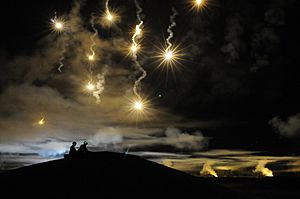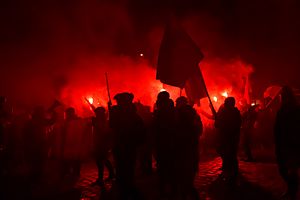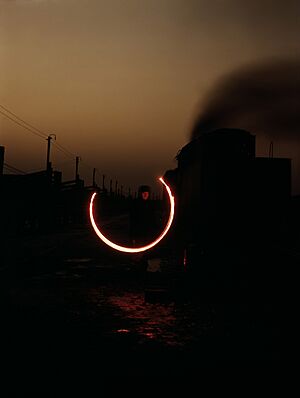Flare facts for kids
A flare is a special device that creates a very bright light or a lot of heat without exploding. Think of it like a super-bright firework that doesn't go "boom!" Flares are used for sending signals, lighting up dark areas, or as a way to protect against threats, both by regular people and in the military.
Flares can be used on the ground, shot into the air like a projectile, or even dropped with a parachute to stay lit for a long time over a big area. They can be dropped from planes, fired from rockets or big guns, or launched from special flare guns or handheld tubes.
Contents
History of Flares
The first time gunpowder was used for sending signals was in China. This happened in 1276 during the Song Dynasty, when the Yuan Dynasty was attacking the city of Yangzhou. They used "signal bombs" that exploded in the air to send messages to soldiers far away.
Another mention of these signal bombs appeared in a text from 1293. By the year 1600, a signal gun was being used in Korea. An old book from 1791, called the Illustrated Military Encyclopedia, even shows a picture of a signal gun.
How Flares Work (Chemistry)
Flares make their light when special chemicals burn. The ingredients can be different, but they often include things like strontium nitrate, potassium nitrate, or potassium perchlorate. These are mixed with a fuel like charcoal, sulfur, sawdust, aluminium, magnesium, or a type of plastic.
Flares can also be made in different colors by adding special color chemicals. Some flares, called calcium flares, are even used underwater to light up things that are submerged.
Flares Without Perchlorate
Many signal flares and military decoy flares today use chemicals called perchlorates. Perchlorate is a type of salt. When it gets into water, it can dissolve and spread quickly in groundwater and surface water.
Even small amounts of perchlorate in drinking water can make it harder for the body to use iodine, which is important for the thyroid gland. Because of this, scientists and environmental groups are looking for ways to make flares that don't use perchlorate, to protect our water and health.
Civilian Uses for Flares
In everyday life, flares are often used as signals. They can be lit on the ground or shot into the air from a flare gun. Flares are a common item found in emergency kits, especially on boats.
Maritime Distress Signals
If you see red flares, either shot into the sky like a rocket or held in someone's hand, it's a widely known sign that someone is in trouble at sea. For example, when the RMS Titanic was sinking, it used rocket-launched distress signals that shot white stars high into the air and made a very loud sound to get help.
Fusee Flares
Another kind of flare is called a fusee. These flares burn for 10 to 60 minutes and give off a bright red light. Fusees are often used to show dangers or warn people to be careful on roads at night. They are also called highway flares or road flares and are often found in car emergency kits.
Fusees are also known as railroad flares. Railroad workers use them to send hand signals. Since they can only be used once, fusees are mostly for emergencies now. But a long time ago, before trains had radios, fusees were used to keep trains safely apart. A railroad fusee would burn for ten minutes. Workers would drop them behind a train to make sure the next train kept a safe distance. If a train saw a burning fusee, it had to wait until it burned out before passing. Railroad fusees have a sharp steel spike on one end so they can be stuck upright into a wooden railroad tie.
In forestry and firefighting, fusees are sometimes used to help put out wildfires or to start controlled burns. They light up at about 191 degrees Celsius (376 degrees Fahrenheit) and can burn as hot as 1600 degrees Celsius (2900 degrees Fahrenheit). They are very good at starting fires in very dry areas, but not as good when things are wet. Firefighters also carry fusees for emergencies. If they get trapped by a fire, they can use a fusee to start a small "escape fire" around themselves to burn away the fuel, creating a safe spot.
Some naval flares use a chemical called calcium phosphide. When this chemical touches water, it creates a gas called phosphine that catches fire on its own when it touches air. It's often used with calcium carbide, which releases acetylene.
|
See also
 In Spanish: Bengala (pirotecnia) para niños
In Spanish: Bengala (pirotecnia) para niños






